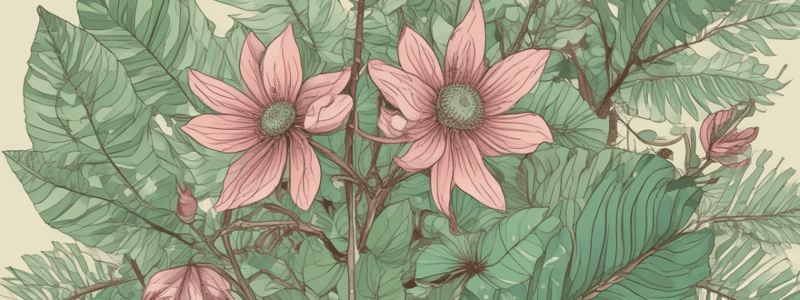Podcast
Questions and Answers
What is the main function of chloroplasts in plant cells?
What is the main function of chloroplasts in plant cells?
- To support leaves and transport materials
- To break down glucose to release energy
- To facilitate photosynthesis (correct)
- To absorb water and nutrients
What is the term for the process by which plants release water vapor into the air?
What is the term for the process by which plants release water vapor into the air?
- Respiration
- Transpiration (correct)
- Photosynthesis
- Seed Germination
Which type of plant produces flowers and seeds?
Which type of plant produces flowers and seeds?
- Flowering Plants (correct)
- Conifers
- Mosses
- Ferns
What is the main function of roots in plant structure?
What is the main function of roots in plant structure?
What is the term for the growth responses of plants to environmental stimuli, such as light and gravity?
What is the term for the growth responses of plants to environmental stimuli, such as light and gravity?
What is the process by which a seed begins to grow?
What is the process by which a seed begins to grow?
Flashcards are hidden until you start studying
Study Notes
Characteristics of Plants
- Multicellular organisms
- Eukaryotic cells
- Autotrophic, meaning they produce their own food through photosynthesis
- Have cell walls made of cellulose
Types of Plants
- Flowering Plants (Angiosperms): produce flowers and seeds, examples include roses and daisies
- Conifers (Gymnosperms): produce cones and seeds, examples include pines and spruces
- Ferns (Pteridophytes): produce spores, examples include ferns and horsetails
- Mosses (Bryophytes): non-vascular, produce spores, examples include mosses and liverworts
Plant Structure
- Roots: underground structures that absorb water and nutrients
- Stems: above-ground structures that support leaves and transport materials
- Leaves: organs that carry out photosynthesis
- Chloroplasts: organelles found in plant cells that contain chlorophyll and facilitate photosynthesis
Plant Functions
- Photosynthesis: process by which plants convert light energy into chemical energy
- Transpiration: process by which plants release water vapor into the air
- Respiration: process by which plants break down glucose to release energy
Plant Growth and Development
- Seed Germination: process by which a seed begins to grow
- Cell Division: process by which plant cells divide and grow
- Hormone Regulation: plant hormones, such as auxins and gibberellins, regulate growth and development
Plant Responses to Environment
- Tropisms: plant growth responses to environmental stimuli, such as light and gravity
- Nastic Movements: plant movements in response to touch or other stimuli
Studying That Suits You
Use AI to generate personalized quizzes and flashcards to suit your learning preferences.




